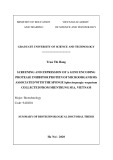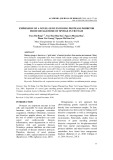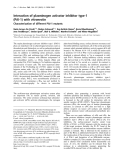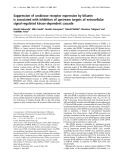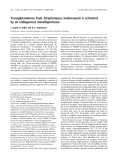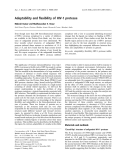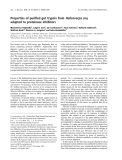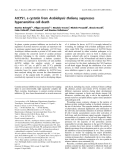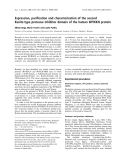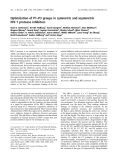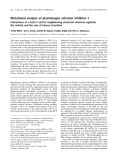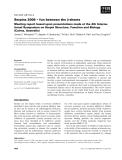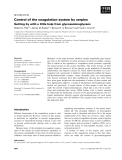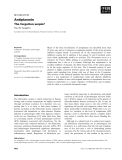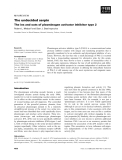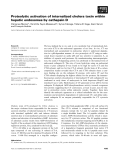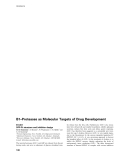
Protease inhibitor
-
Detection and screening of genes related to biosynthesis of substances with protease inhibitory activity from microorganisms associated with sponge collected from the Mien trung sea of Vietnam by metagenomics method. Then, selective gene, expression of in vitro and determination of activity of the expressed protein.
 27p
27p  capheviahe26
capheviahe26
 25-01-2021
25-01-2021
 17
17
 3
3
 Download
Download
-
In this study, we selected a novel gene encoding protease inhibitor from metagenome of marine sponge QT collected in Quang Tri and expressed in the Escherichia coli (E. coli) strain BL21(DE3) for finding and mining novel protease inhibitor.
 8p
8p  shiwo_ding7
shiwo_ding7
 05-06-2019
05-06-2019
 34
34
 1
1
 Download
Download
-
The serpin plasminogen activator inhibitor type 1 (PAI-1) plays an important role in physiological processes such as thrombolysis and ®brinolysis, as well as pathophysiological processes such as thrombosis, tumor invasion and metas-tasis. In addition to inhibiting serine proteases, mainly tissue-type (tPA) and urokinase-type (uPA) plasminogen activators, PAI-1 interacts with dierent components of the extracellular matrix, i.e. ®brin, heparin (Hep) and vitronectin (Vn).
 9p
9p  research12
research12
 29-04-2013
29-04-2013
 25
25
 3
3
 Download
Download
-
Our laboratory showed that bikunin, aKunitz-type protease inhibitor, suppresses 4b-phorbol 12-myristate 13-acetate (PMA)- or tumor necrosis factor-alpha (TNFa)-induced urokinase-type plasminogen activator (uPA) expression in different cell types. In addition to its effects on protease inhibition, bikunincouldbemodulatingother cellular events associated with the metastatic cascade.
 13p
13p  research12
research12
 23-04-2013
23-04-2013
 42
42
 2
2
 Download
Download
-
The aimof this workwas to elucidate the roles of individual residues within the flexible second binding loop of human cystatin A in the inhibition of cysteine proteases. Four recombinant variants of the inhibitor, each with a single mutation, L73G, P74G, Q76G or N77G, in the most exposed part of this loopwere generated by PCR-based site-directed mutagenesis. The binding of these variants to papain, cathepsin L, and cathepsin B was characterized by equilibrium and kinetic methods.
 10p
10p  tumor12
tumor12
 22-04-2013
22-04-2013
 34
34
 2
2
 Download
Download
-
Báo cáo khoa học: Human proteoglycan testican-1 inhibits the lysosomal cysteine protease cathepsin L
Testican-1, a secreted proteoglycan enriched in brain, has a single thyropin domain that is highly homologous to domains previously shown to inhibit cysteine proteases. We demonstrate that purified recombinant human testican-1 is a strong competitive inhibitor of the lysosomal cysteine pro-tease, cathepsin L,withaKiof 0.7nM, but it does not inhibit the structurally related lysosomal cysteine protease cathep-sin B. Testican-1 inhibition of cathepsin L is independent of its chondroitin sulfate chains and is effective at both pH 5.5 and7.2.
 8p
8p  tumor12
tumor12
 20-04-2013
20-04-2013
 33
33
 4
4
 Download
Download
-
Streptomyces mobaraensis secretes a Ca 2+ -independent transglutaminase (TGase) that is activated by removing an N-terminal peptide from a precursor protein during sub-merged culture in a complex medium [Pasternack, R., Dorsch, S., Otterbach, J. T., Robenek, I. R., Wolf, S. & Fuchsbauer, H.-L. (1998)Eur. J. Biochem. 257, 570–576]. However, an activating protease could not be identified, probably because of the presence of a 14-kDa protein (P14 ) belonging to theStreptomycessubtilisin inhibitor family. ...
 9p
9p  tumor12
tumor12
 20-04-2013
20-04-2013
 29
29
 2
2
 Download
Download
-
Even though more than 200 three-dimensional structures of HIV-1 protease complexed to a variety of inhibitors are available in the Protein Data Bank; very few struc-tures of unliganded protein have been determined. We have recently solved structures of unliganded HIV-1 protease tethered dimer mutants to resolutions of 1.9 A˚ and 2.1 A ˚ , and have found that the flaps assume closed-flap conformation even in the absence of any bound lig-and.
 9p
9p  tumor12
tumor12
 20-04-2013
20-04-2013
 21
21
 2
2
 Download
Download
-
Macrophages at an inflammatory site release massive amounts of proteolytic enzymes, including lysosomal cys-teine proteases, which colocalizewith their circulating, tight-binding inhibitors (cystatins, kininogens), so modifying the protease/antiprotease equilibrium in favor of enhanced proteolysis. We have explored the ability of human cath-epsins B, KandL to participate in the production of kinins, using kininogens and synthetic peptides that mimic the insertion sites of bradykinin on human kininogens....
 8p
8p  tumor12
tumor12
 20-04-2013
20-04-2013
 44
44
 5
5
 Download
Download
-
Pest insects such asHelicoverpaspp. frequently feed on plants expressing protease inhibitors. Apparently, their digestive system can adapt to the presence of protease inhibitors. To study this, a trypsin enzymewas purified from the gut of insects that were raised on an inhibitor-containing diet. The amino-acid sequence of this enzyme was analysed by tandem MS, which allowed assignment of 66% of the mature protein amino acid sequence. This trypsin, called HzTrypsin-S, corresponded to a known cDNA sequence fromHelicoverpa. ...
 10p
10p  tumor12
tumor12
 20-04-2013
20-04-2013
 26
26
 3
3
 Download
Download
-
Báo cáo khoa học: AtCYS1, a cystatin from Arabidopsis thaliana, suppresses hypersensitive cell death
In plants, cysteine protease inhibitors are involved in the regulation of protein turnover and play an important role in resistance against insects and pathogens. AtCYS1from Arabidopsis thalianaencodes a protein of 102 amino acids that contains the conserved motif of cysteine protease inhibitors belonging to the cystatin superfamily (Gln-Val-Val-Ala-Gly). Recombinant A. thaliana cystatin-1 (AtCYS1) was expressed in Escherichia coliand purified.
 12p
12p  fptmusic
fptmusic
 16-04-2013
16-04-2013
 25
25
 3
3
 Download
Download
-
Recently we have described a novel secreted protein (the WFIKKN protein) that consists of multiple types of prote-ase inhibitory modules, including two tandem Kunitz-type protease inhibitor-domains. On the basis of its homologies we have suggested that the WFIKKN protein is a multi-valent protease inhibitor that may control the action of different proteases.
 7p
7p  fptmusic
fptmusic
 16-04-2013
16-04-2013
 40
40
 3
3
 Download
Download
-
Báo cáo khoa học: Optimization of P1–P3 groups in symmetric and asymmetric HIV-1 protease inhibitors
HIV-1 protease is an important target for treatment of AIDS, and efficient drugs have been developed. However, the resistance and negative side effects of the current drugs has necessitated the development of new compounds with different binding patterns. In this study, nine C-terminally duplicated HIV-1 protease inhibitors were cocrystallised with the enzyme, the crystal structures analysed at 1.8–2.3 A˚ resolution, and the inhibitory activity of the compounds characterized inorder toevaluate the effects of the individual modifications. ...
 13p
13p  fptmusic
fptmusic
 16-04-2013
16-04-2013
 44
44
 3
3
 Download
Download
-
The serpin plasminogen activator inhibitor-1 (PAI-1) is a fast and specific inhibitor of the plasminogen activating serine proteases tissue-type and urokinase-type plasminogen activator and, as such, an important regulator in turnover of extracellularmatrixand infibrinolysis. PAI-1 spontaneously loses its antiproteolyticactivityby inserting its reactive centre loop (RCL) as strand 4 in b-sheet A, thereby converting to the so-called latent state.
 9p
9p  fptmusic
fptmusic
 16-04-2013
16-04-2013
 26
26
 3
3
 Download
Download
-
Serpins are the largest family of protease inhibitors and are fundamental for the control of proteolysis in multicellular eukaryotes. Most eukaryote serpins inhibit serine or cysteine proteases, however, noninhibitory mem-bers have been identified that perform diverse functions in processes such as hormone delivery and tumour metastasis. More recently inhibitory ser-pins have been identified in prokaryotes and unicellular eukaryotes, never-theless, the precise molecular targets of these molecules remains to be identified....
 6p
6p  fptmusic
fptmusic
 12-04-2013
12-04-2013
 36
36
 2
2
 Download
Download
-
Members of the serine protease inhibitor (serpin) superfamily play import-ant roles in the inhibition of serine proteases involved in complex systems. This is evident in the regulation of coagulation serine proteases, especially the central enzyme in this system, thrombin. This review focuses on three serpins which are known to be key players in the regulation of thrombin: antithrombin and heparin cofactor II, which inhibit thrombin in its pro-coagulant role, and protein C inhibitor, which primarily inhibits the throm-bin⁄thrombomodulin complex, where thrombin plays an anticoagulant role. .
 10p
10p  fptmusic
fptmusic
 12-04-2013
12-04-2013
 39
39
 3
3
 Download
Download
-
Much of the basic biochemistry of antiplasmin was described more than 20 years ago and yet it remains an enigmatic member of the serine protease inhibitor (serpin) family. It possesses all of the characteristics of other inhibitory serpins but in addition it has unique N- and C-terminal exten-sions which significantly modify its activities. The N-terminus serves as a substrate for Factor XIIIa leading to crosslinking and incorporation of antiplasmin into a clot as it is formed.
 6p
6p  fptmusic
fptmusic
 12-04-2013
12-04-2013
 29
29
 2
2
 Download
Download
-
Plasminogen activator inhibitor type-2 (PAI-2) is a nonconventional serine protease inhibitor (serpin) with unique and tantalizing properties that is generally considered to be an authentic and physiological inhibitor of uro-kinase. However, the fact that only a small percentage of PAI-2 is secreted has been a long-standing argument for alternative roles for this serpin.
 10p
10p  fptmusic
fptmusic
 12-04-2013
12-04-2013
 38
38
 2
2
 Download
Download
-
We have defined thein vivo andin vitro metabolic fate of internalized chol-era toxin (CT) in the endosomal apparatus of rat liver. In vivo, CT was internalized and accumulated in endosomes where it underwent degrada-tion in a pH-dependent manner. In vitro proteolysis of CT using an endo-somal lysate required an acidic pH and was sensitive to pepstatin A, an inhibitor of aspartic acid proteases.
 13p
13p  fptmusic
fptmusic
 11-04-2013
11-04-2013
 34
34
 3
3
 Download
Download
-
The incretin hormones GLP-1 and GIP are released from the gut during meals, and serve as enhancers of glucose stimulated insu-lin release from the beta cells. Furthermore, GLP-1 also stimu-lates beta cell growth and insulin biosynthesis, inhibits glucagon secretion, reduces free fatty acids and delays gastric emptying. GLP-1 has therefore been suggested as a potentially new treat-ment for type 2 diabetes.
 46p
46p  fptmusic
fptmusic
 11-04-2013
11-04-2013
 36
36
 3
3
 Download
Download
CHỦ ĐỀ BẠN MUỐN TÌM








